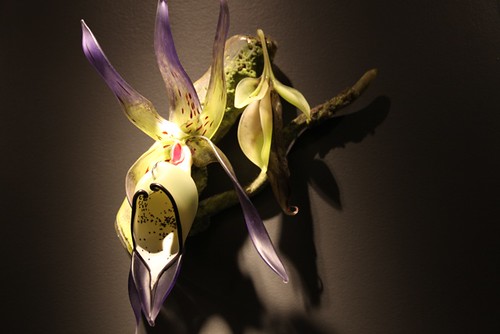Richard Craig Meitner:
The intellectual, poetic, and always changing work of the American artist Richard Craig Meitner (b. 1949) reflects a variety of influences and ideas, from Japanese textiles and Italian painting and applied arts to science and the natural world. The colorless glass surfaces of his quixotic objects often incorporate assorted materials such as rust, enamel, bronze, tile, paint, and print. Meitner revels in unusual juxtapositions of forms and ideas, in unanswered questions, and in the intersections between art and science.
"Perhaps we can say that art and science are attempts, by very different methods, to get at the same truths. Both are directed at finding out more about ourselves, and the universe we inhabit, by studying and recording. Science attempts to explain the universe by assuming causality, linear time, and the existence of hidden rules or patterns which, if diligent enough, we can discover and understand. Art attempts to explain the universe more intuitively, emotionally, and even magically. Science depends largely on the genius of the intellect, and art on the genius of the spirit."
—Richard Craig Meitner, Glass Art Society Journal (2001), p. 66.
Meitner's aim in making images and objects, he says, is to create moments of astonishment and surprise, “magical” moments when the viewer, questioning what he or she is seeing, begins to think about things and the relationships between them in new ways. “Magic,” he says, “is a moment in which something happens that does not fit into your belief system.” When you are not thinking along established neural paths, you are thinking creatively.
Meitner’s desire to change the ways in which things are perceived and his on-going pursuit of beauty link him with the French Surrealists, who also worked in the realm of the marvelous (la merveille), where beauty was convulsive, a force of power and meaning. Meitner’s objects are related to the Surrealists’ “object-poems,” universes unto themselves where the physics of poetry reigns.
Through his work, Meitner does not aim to make statements about anything and he is not trying to tell the viewer what he knows. Rather, Meitner is trying to communicate what he does not know, and he does so using pictures rather than words. For him, art functions as it ideally should, which is as a place where questions are asked and not necessarily answered, a place where any and all things may be considered. If you think you understand Meitner’s objects at first glance, you need to look again.
“Masters of Studio Glass: Richard Craig Meitner” showcases a range of the artist’s work that is held in the Museum’s permanent collection, which includes early blown vessels, with graphic images made of fired enamels, to later multi-media sculptures. The 30 objects in the exhibition, dating from 1978 to 2001, span 23 years of the artist’s prolific career, and they show the many facets of Meitner’s artistic vision. The exhibition also presents one of Meitner’s installations, a series of four sculptures titled Ognico/Sahala/Suasta/Gione (For Everything There is a Season). This installation on the theme of the four seasons was commissioned for the Venezia Aperto Vetro exhibition in Venice, Italy in 1998.







